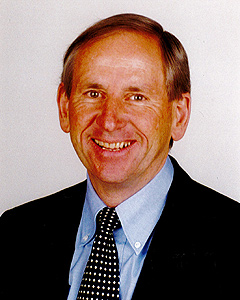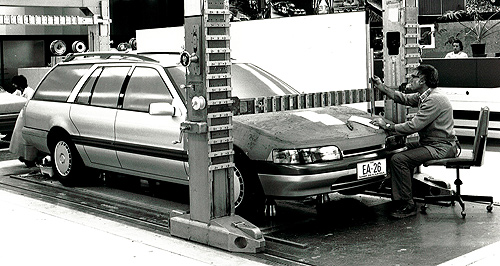News - FordHow Ford knocked back an export FalconWhat might have been: Ford turned down an Australian plea to permit a locally developed left-hand-drive Falcon for export markets in the 1980s – a move that might have changed Ford fortunes in Australia. Retired engineering chief says he tried to get Ford to commit to LHD Falcon1 Oct 2016 A FORMER Ford Australia vice-president of product development has revealed how he attempted to get Ford Motor Company to sign off on a left-hand-drive version of the Australian-developed Falcon for export in the 1980s to help secure its future. Ian Vaughan, who retired from the company in 2001 after 37 years in engineering roles, said he also tried to convince head office in Detroit to substitute the Falcon and Fairlane for the Ford Crown Victoria and Taurus in the Middle East to give Australian-built cars a defined export market, just as General Motors did for Holden’s Commodore and Caprice. “Unfortunately, I did not succeed,” he said. “That would have perhaps opened some doors to make Falcon into a global platform.” As history will show, Falcon production volumes have continually shrunk since Falcon’s halcyon days of the top-selling XE and XF in the mid-1980s, reaching the point where production will stop altogether this Friday when Ford closes its Australian plants in Geelong and Broadmeadows. While Mr Vaughan is sad to see manufacturing go, he says he is proud of the engineering legacy built by Ford over five decades in Australia, forming the basis for today’s fast-growing Ford Asia-Pacific Vehicle Development operation in Victoria. “I think it is the product of the last 50 years, where we started off with an American car and then we learnt it wasn’t good enough for Australian conditions,” he told GoAuto in an interview ahead of this week’s factory shutdown. “So we re-engineered it and re-engineered it and in the process were learned how to design motor cars. “There were other bits along the way, such as the Territory which taught us how to design Ranger and Everest. That was a natural evolution there. “We might be phasing out of the manufacturing industry – a second industry – but here is a tertiary industry – a service industry called engineering – where we are world competitive.” Mr Vaughan said that while governments might have provided more incentives to bolster automotive research and development in Australia, perhaps encouraging a more global focus, Ford has ended up with a fine vehicle development outcome in Australia. “The company has got to want to do it with their own money,” he said.  Left: Former Ford Australia vice-president of product development Ian Vaughan.Mr Vaughan, possibly best known publicly for driving a factory-backed Ford XT Falcon GT to third place and a teams’ win in the iconic London-to-Sydney Marathon in 1968, said assets such as the You Yangs proving ground came about because of the need to improve early Falcons such as the 1960s XK, XL and XM. Left: Former Ford Australia vice-president of product development Ian Vaughan.Mr Vaughan, possibly best known publicly for driving a factory-backed Ford XT Falcon GT to third place and a teams’ win in the iconic London-to-Sydney Marathon in 1968, said assets such as the You Yangs proving ground came about because of the need to improve early Falcons such as the 1960s XK, XL and XM.“Before the proving ground was built in the late 1960s, we used to test in the back of beyond,” he said. “They still do that, but the importance of the test track at the You Yangs is you have repetitive testing – same standard, same speed, same driver – doing stuff which is measurable.” Mr Vaughan said that as one of only three vehicle development centres in the Ford world, Ford’s Australian operation was now fully hooked into the global system via 3D virtual engineering, computer-aided design and other systems. “That is one of the good things about being part of a worldwide engineering operation – if they invent something in Cologne or Detroit, they just pass it on to this engineering centre,” he said. Mr Vaughan said the future had never been brighter for Ford engineering in Australia where Ford Asia-Pacific Vehicle Development is working on designing and engineering vehicles for global markets. “They have done a super job on the Ranger,” he said. “The Ranger and Everest have been fabulous.” Mr Vaughan said that when he heard that Ford Australia’s manufacturing operations were to close, he was concerned whether the design and engineering operation could continue in that vacuum. “I thought, ‘Gee, what’s going to happen to simultaneous engineering, where you design the car and then you design the process, side-by-side,’” he said. “I thought, ‘Where are the process engineers going to come from we haven’t got a plant down the road to call on.’“But they set up an organisation of process engineers – manufacturing engineers – to run right alongside the design engineers in designing the car. So we haven’t lost that simultaneous engineering which is vital to getting a good outcome on the production line.” While Mr Vaughan has no official capacity at Ford since retirement, he says he likes to keep in touch and see how things are going in the vehicle development world. He also keeps busy as a director on the boards of three companies, including one that previously stamped car parts but which is carving a new niche in solar panel frames.  Read more1st of October 2016  Ford workers find a futureRapid rise of Ford vehicle development eases job pain for 157 factory workers1st of October 2016  Blue day for FordFord’s Australian factories just days away from closure after nine decades1st of October 2016  Six of the best for axed Ford workers‘Golden Ticket’ draw for six final Falcons set to ease worker pain at Ford11th of February 2015  Ford Australia denies early exit reportAustralian Ford factories to stick with planned closure in 2016, says Ford Australia21st of October 2014  Production starts on Ford’s final FalconThe first of Ford’s Falcon FG X and SZ Territory MkII have rolled off the line |
Click to shareFord articlesResearch Ford Motor industry news |
















Facebook Twitter Instagram